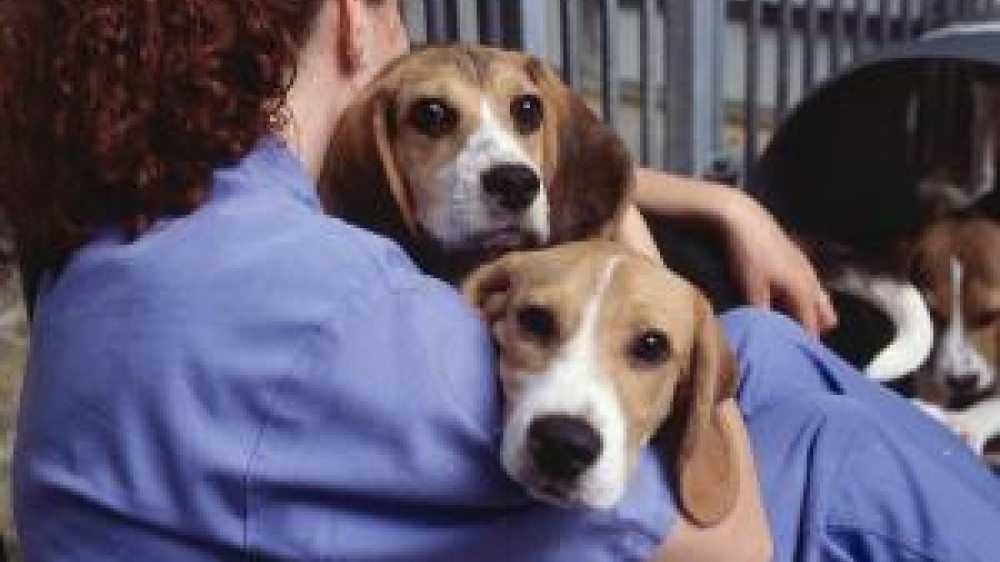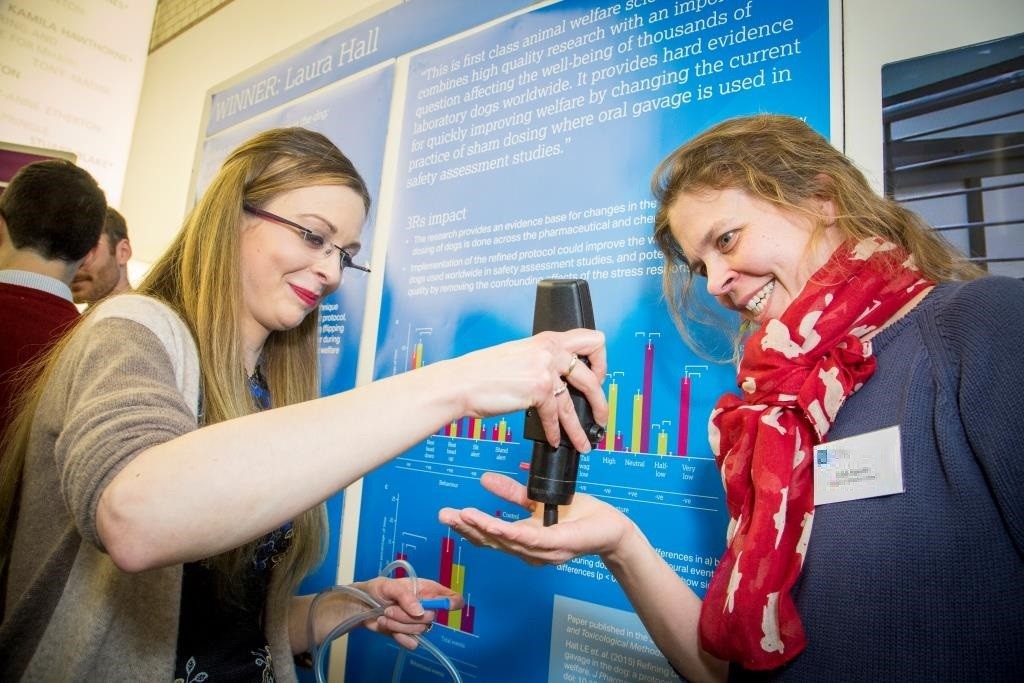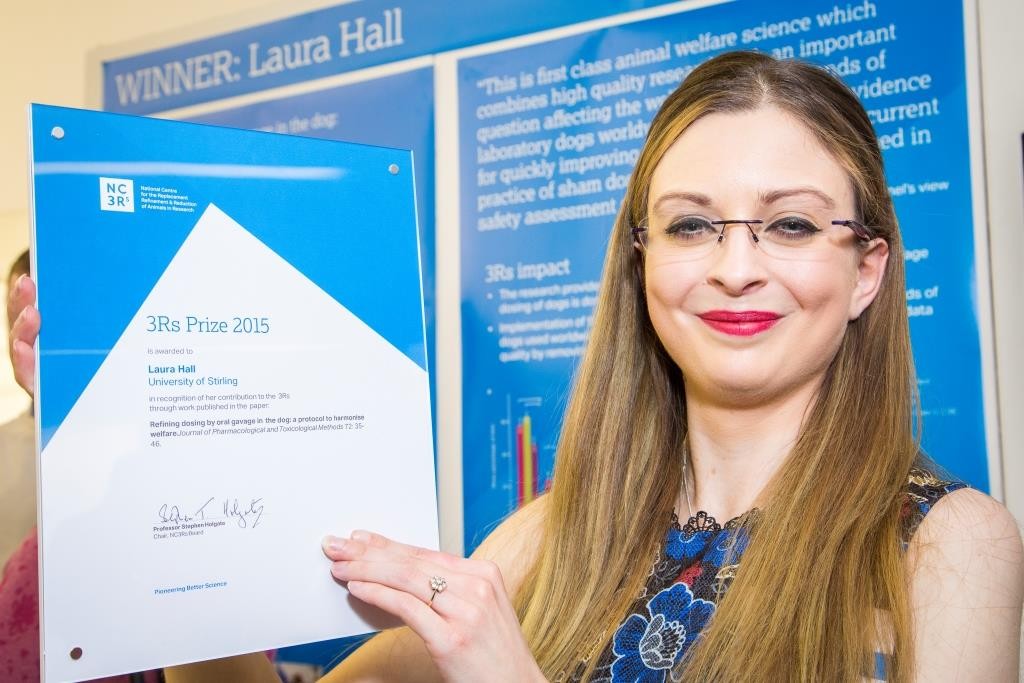Improving the welfare of laboratory dogs

They say you can’t teach an old dog new tricks. But what about scientists and new procedures?
Research on refining oral dosing in dogs recently received the annual NC3Rs 3Rs Prize. The work, by Dr Laura Hall from University of Stirling and colleagues, has been published in the Journal of Pharmacological and Toxicological Methods. In collaboration with AstraZeneca, Dr Hall developed the first framework to assess the welfare of the laboratory dog based on their behaviour, health and psychological well-being, and used it to show that the currently used methods for oral dosing can be improved.
Delivering drugs orally is often done by gavage, where a thin tube is inserted briefly into the stomach through the mouth. “Sham dosing” (dosing without administering the drug) is typically used before the treatment, on the basis that it should help familiarise dogs with the procedure.
Dr Hall has for the first time demonstrated that this was not the case. She gathered the evidence using a framework that measures a number of parameters to objectively assess the welfare of the dogs, such as patterns in behaviour, cardiovascular parameters, judgement bias and mechanical pressure threshold (MPT, as shown in the picture).

Dr Hall presenting the work of mechanical pressure threshold (MPT) device at the 3Rs Prize ceremony.
The study compared control group with no training or treatment before dosing, and a group that was sham dosed before the final dosing phase (see the table below for details). When the framework was applied to the gavage procedure, sham dosed dogs showed more signs of negative welfare in the dosing phase than the control group.
Based on these findings, Dr Hall then developed a modified and refined protocol for habituation and training. This included positive training with food rewards, a signal for dosing to make the dog aware that the procedure is about to start, and covering the gavage tube in palatable paste during pre-treatment training (table below shows the direct comparison of handling of each of the groups).These small refinements were found to reduce the negative welfare impact of the gavage procedure on the dogs.
Handling of each of three groups:
|
Group |
Training phase |
Sham dosing phase |
Dosing phase |
|
Control |
No treatment |
No treatment |
Daily dosing (vehicle only) |
|
Sham dosed |
No treatment |
Sham dosing (two times, standard protocol) |
Daily dosing (vehicle only) |
|
Refined protocol |
Four training sessions |
Sham dosing (two times, refined protocol) |
Daily dosing (vehicle only) with modifications (signal for dosing) |
The group of dogs under the refined procedure showed improved welfare when assessed using the framework in comparison to both the control and the sham dosed group. The new protocol also allowed the researchers to dose the dogs more quickly and efficiently.
Dr Hall got the idea of covering the dosing tube with palatable vitamin paste from her mother, who is a nurse. Sometimes it is possible to apply ideas from patients to research animals, and it has worked well in this case. Dr Hall said: “My mum pointed out that when a patient has a nasogastric tube inserted, it is more comfortable for the patient if they swallow a glass of water simultaneously. This gave me the idea to encourage the dogs to swallow during gavage training by coating the tube in a pleasant-tasting paste.”
Over 3,500 dogs are used in research and testing in the UK every year, most of them in regulatory safety studies1. Oral dosing is one of the most common procedures used in toxicity studies, and therefore the findings of this work have the potential to minimise stress in thousands of dogs, not just in the UK but also worldwide.
This simple refinement is cost effective, requires no changes to the infrastructure and can be implemented widely to improve welfare and reduce the adverse impact of procedures, with potential to improve the quality of scientific output.

Dr Hall has put great effort into disseminating her work. Based on the evidence of the study, partners at AstraZeneca have already successfully applied the training protocol, and she is now collaborating with other dog facilities across the UK, who are keen to implement the improved procedures, as well as develop further refinements and share best practice. Her new website, Refining Dog Care, is launching soon as part of a collaborative project sharing existing best practice, developing new evidence-based refinements and offering CPD on training and welfare assessment.
The NC3Rs international 3Rs Prize, sponsored by GlaxoSmithKline, is awarded every year to highlight recent publications with exceptional contribution to scientific and technological advances in the 3Rs in medical, biological or veterinary sciences, published in a peer-reviewed journal in the last three years. The prize consists of a grant of £18k, plus a personal award of £2k. The applications are judged by an independent panel of experts and the prize is presented during an award ceremony, attended this year by more than 150 NC3Rs stakeholders and guests from the scientific community.
Commenting on the award, Dr Vicky Robinson CBE, Chief Executive of the NC3Rs said: “This is first class animal welfare science which combines high quality research with an important question affecting the well-being of thousands of laboratory dogs worldwide.
“This work also reminds us of the importance of re-visiting common procedures, to make sure the protocols are guided by evidence and not by anecdotes or assumptions.”
When asked about the future, Dr Hall said that her aim is to use the prize (£18k) to replicate and further expand the study by applying the principles to other regulated procedures in the dog. The money will allow her to investigate the effects of other refinements for single-housing, inhalation studies or telemetry studies where animals wear jackets.
1Annual Statistics of Scientific Procedures on Living Animals Great Britain 2014, H. Office, Editor 2014, Williams Lea Group on behalf of the Controller of Her Majesty’s Stationery Office. United Kingdom.
